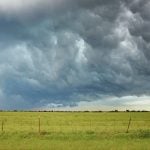It’s north verses south for seeding progress, and for progress of last year’s leftover harvest, across much of Western Canada.
This spring has seen exceptional progress in some areas, while states of disaster have been declared in other parts.
Southern regions are enjoying a relative stable seeding season, while northern areas continue to struggle with getting last year’s harvest in the bin and this year’s crop in the ground.
In Manitoba, seeding operations progressed well during the week and it’s estimated that about 90 percent of crops are planted.
Read Also

Ukraine may disrupt wheat market
The EU is curtailing its wheat imports, forcing Ukraine to find new markets at a time of stagnating demand.
Southern regions of Saskatchewan and Alberta are advancing quickly thanks to warm, dry weather.
Rainfall, particularly in northwestern and northeastern Alberta has many fields too wet for harvest or seeding.
Most crops are at or behind normal development stages for this time of year.
However, sunny days has favoured one region in particular, which stands out above the rest this year.
“Here in southeast Saskatchewan, I think everyone is pretty well smiling and happy. Everything is looking good at this point and all we can do is knock on wood and hope the rains come at a timely manner and we get some heat and I think things will take off and really grow,” said Sherri Roberts, regional crops specialist with Saskatchewan’s Ministry of Agriculture.
“We have some fall rye and winter wheat already starting to head out. We’ve got peas at the three and four node stage, which is progressing really well. We’ve got canola up and looking good.”
However, in Alberta’s northeast region states of disaster have been declared because of excess moisture.
“St. Paul County and Beaver County have both declared agricultural disasters on a local basis,” said Barry Yaremcio, beef and forage specialist with Alberta Agriculture and Forestry.
“It’s unreal with the amount of water that is just sitting around. So instead of seeding 140 acres a quarter they might be able to get on to 60. That kind of thing,” he said.
“There’s farmers in that area that haven’t turned a wheel yet for harvest or seeding.”
Arnold Hanson, livestock producer and a councillor for Beaver County, said conditions are so wet in some areas that last year’s harvest is still sitting in water.
He said the main reason for declaring a disaster was to draw attention to the economic hardships farmers are facing.
“The (crop insurance) programs that we have don’t really address the issues that we’re having. They keep telling producers to try and get the crop off. Well, when the crop is sitting in two feet of water, they’ll never get it off in order to get their insurance proceeds,” he said.
“We need to change some of the programs so they address the issues that are there with insurance and the needs of producers.”
Yaremcio said as the seeding window closes, farmers’ crop options are rapidly becoming limited.
Decisions have to be made.
“That’s the calls that we’re getting here right now. ‘OK, can I go ahead and seed this variety, or what are my options for what to do with my acres?’ ” he said.

















